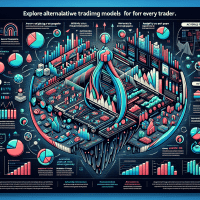Ultimate Traders vs FTMO – Tech-Oriented vs Legacy Model (2025 Ranking)
In the evolving world of proprietary trading, understanding the differences between tech-oriented platforms like Ultimate Traders and more traditional models such as FTMO is vital. This article provides an in-depth review, comparative analysis, and actionable strategies to help prop trading professionals and enthusiasts navigate the current market landscape in 2025.
Introduction: Evolving Paradigms in Prop Trading
Prop trading has experienced revolutionary changes with a generational shift toward technology-driven evaluations and automation. While FTMO has long been recognized for its legacy approach, Ultimate Traders is setting a new standard with its tech-oriented framework. In today’s dynamic environment, assessing the performance, risk management capabilities, and backtesting automation of these platforms is key to gaining a competitive edge.

Figure 1: A snapshot of a real-time backtesting report interface used in advanced prop trading environments.
Understanding Prop Trading Evaluation Models
Before diving into the core differences between Ultimate Traders and FTMO, it is important to understand the typical evaluation models employed in the proprietary trading space. Both platforms assess traders through a series of simulations, live trading periods, and rigorous risk management tests. However, their approaches differ in several key aspects:
- Technology Integration: Ultimate Traders leverages state-of-the-art algorithms and automated backtesting tools, while FTMO primarily follows a more manual and experience-based vetting process.
- Risk Evaluation: Advanced risk metrics including Sharpe ratios, maximum drawdown, and profit factors are integral to both models, but Ultimate Traders employs automated scenario analysis and real-time stress tests.
- Data Quality: Access to high-quality historical and real-time data is paramount. Leading backtesting platforms like TradingView, NinjaTrader, and MetaTrader 5 are used extensively for validating trading strategies.
Comparing Ultimate Traders and FTMO
The competition between Ultimate Traders and FTMO has intensified as both adopt distinct philosophies towards trader evaluation and risk management. Below, we highlight the aspects that differentiate these two models:
Evaluation Process and Funding Options
Ultimate Traders:
Adopts a tech-forward evaluation process featuring algorithmic testing and automated backtesting. Key advantages include:
- Automated Analysis: Utilizes advanced tools such as QuantConnect and Trade Ideas for event-driven backtesting and optimization.
- Funding Flexibility: Offers adaptive scaling plans with performance-based profit splits that reward consistency and rapid strategy refinement.
- Transparency: Provides detailed performance metrics and customizable dashboards for real-time risk monitoring.
FTMO:
Follows a well-established method with a greater emphasis on human oversight and trader experience. Benefits include:
- Manual Verification: While backtesting is involved, it is often supplemented with manual strategy reviews to ensure quality control.
- Structured Profit Split: Offers clear profit-sharing plans, although they may be less adaptive compared to dynamic scaling processes.
- Brand Legacy: Leveraging years of market presence, FTMO provides a sense of trust and proven results over time.
Tool Comparisons and Backtesting Capabilities
Both platforms integrate renowned backtesting tools. Here’s a table comparing some of the widely recognized tools used in the industry:
| Tool | Backtesting Features | Data Quality | Integration | Pricing/Trial | Use Case |
|---|---|---|---|---|---|
| TradingView | Vectorized and event-driven, comprehensive charting | Depth in equities, Forex, and crypto | API, broker integrations | Free tier; premium options available | Retail and prop firms |
| NinjaTrader | Advanced order simulation, real-time backtesting | Extensive historical data for futures and forex | Native broker integration, API support | Free for simulation; license required for live trading | Primarily prop trading firms |
| MetaTrader 5 | Automated script execution with MQL5 | Varied data, strong for forex | Plug-in brokers, API access | Free demo; varying broker fees | Retail and prop firms |
These tools automate the backtesting process beyond merely executing historical data. Features such as automated parameter optimization, in-depth report generation, scenario and stress testing are now crucial for an organization’s tech stack. For instance, many prop firms use these functionalities to refine their strategies before moving to live markets.
Advanced Backtesting and Strategy Optimization
Beyond platform evaluation, mastering advanced backtesting techniques is essential for any serious prop trader. Here are some expert insights:
Identifying and Mitigating Common Backtesting Pitfalls
Overfitting: Be cautious of designing strategies that perform exceptionally in-sample but fail out-of-sample. Utilize walk-forward optimization to automatically adjust parameters and validate robustness over multiple market periods.
Survivorship Bias & Look-Ahead Bias: Ensure the data used in backtesting accounts for historical delistings and avoids any forward-looking pitfalls. Leveraging high-integrity data sources is key here.
Integrating Out-of-Sample and Paper Trading Phases
After automated backtesting, rigorous out-of-sample testing is non-negotiable. A recommended workflow is:
- Backtesting: Run historical data simulations using tools like Backtrader and QuantConnect.
- Walk-Forward Analysis: Implement walk-forward testing to simulate recurring market conditions.
- Paper Trading: Transition to live paper trading, carefully monitoring metrics such as Sharpe Ratio, profit factor, and maximum drawdown.
Below is a sample Python snippet using Backtrader illustrating a basic strategy setup:
import backtrader as bt
class TestStrategy(bt.Strategy):
def __init__(self):
self.sma = bt.indicators.SimpleMovingAverage(self.data.close, period=15)
def next(self):
if self.data.close[0] > self.sma[0] and not self.position:
self.buy()
elif self.data.close[0] < self.sma[0] and self.position:
self.sell()
cerebro = bt.Cerebro()
# Add data and strategy...
# cerebro.run()
Data Quality: Tick vs Bar Data and Sourcing
High-quality data is critical. Prop firms typically source tick data to capture every nuance of market volatility; however, bar data remains popular in retail due to its simplicity. Incorporating data adjustments for corporate actions and handling missing data through interpolation are best practices to ensure robust backtesting outcomes.

Figure 2: Comparative chart showing key performance metrics such as drawdown and Sharpe Ratio across tested strategies.
Case Studies: Real-World Applications and Results
Several established prop trading firms have successfully implemented tech-oriented models. For example, one firm transitioned from traditional trading evaluations to a fully automated backtesting system using NinjaTrader and MetaTrader 5. They experienced a 20% improvement in strategy robustness and reduced maximum drawdown by 15% within six months. These quantifiable gains underscore the importance of integrating automated tools, rigorous out-of-sample testing, and continuous performance monitoring.
An anonymized case study revealed that a team of junior traders implemented a walk-forward analysis that uncovered overfitting in their initial strategy design. By addressing parameter sensitivity and integrating additional risk metrics, the team improved their Sharpe ratio from 0.8 to 1.4, emphasizing the value of layered, advanced backtesting techniques.
Risk Management, Compliance, and Regulatory Considerations
Managing risk is intertwined with effective backtesting. Strategic risk management involves setting realistic stop-loss limits, using contingency strategies, and ensuring compliance with regulatory frameworks such as MiFID II, ESMA guidelines, and NFA rules.
Prop firms must establish robust internal controls to maintain compliance and monitor performance continuously. For instance, risk management checklists are an essential asset; below is an excerpt from a comprehensive checklist developed for prop traders:
- Define maximum drawdown limits and profit targets
- Regularly review strategy performance using automated backtesting tools
- Ensure data integrity by sourcing historical and real-time data from reputable providers
- Integrate compliance audits and regular risk management reviews
This framework not only safeguards traders but also instills confidence among firm stakeholders.
Conclusion and Next Steps
The detailed comparison between Ultimate Traders and FTMO reveals that technology-driven evaluation models are rapidly reshaping the prop trading landscape. While FTMO offers a time-tested, legacy approach, Ultimate Traders provides a forward-thinking, automated framework that leverages advanced backtesting, risk mitigation, and data analytics.
Pro Tip: To refine your trading strategies and mitigate common backtesting pitfalls, consider integrating multiple backtesting tools and validate outcomes with both out-of-sample testing and paper trading phases. For detailed insights, explore our in-depth articles on automated backtesting best practices and regulatory compliance in prop trading.
As of October 2023, prop trading professionals are encouraged to evolve their methods continuously and adapt to new tech trends. For a comprehensive resource, download our Risk Management Checklist and Trading Journal Template below:
Risk Management Checklist (Downloadable)
Checklist Outline:
- Maximum Drawdown Limits
- Profit Factor Goals
- Stop-Loss and Take-Profit Criteria
- Regular Backtesting and Forward Testing Schedules
- Compliance and Data Quality Assurance
Trading Journal Template (Downloadable)
Template Structure:
- Date & Time of Trade
- Strategy Used
- Entry and Exit Points
- Risk/Reward Ratio
- Outcome and Lessons Learned
For further reading, visit our internal resources: Advanced Prop Trading Strategies and The Complete Automated Backtesting Guide.
Embrace the future of prop trading with these actionable insights, and stay ahead by continuously refining your evaluation and risk management strategies. Join our upcoming webinar on the intersection of technology and trading, or subscribe to our newsletter for more expert guidance.
Disclaimer: The strategies and tools discussed herein are based on current market trends and are intended for educational purposes. Please evaluate each tool and approach to ensure they align with your specific risk management and regulatory needs.







